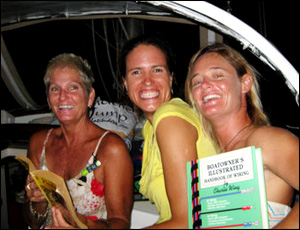 |
| Returning to our starting point of Ensenada felt like the definition of failure. |
At 16o 36.050 S and 97o 31.080 W we turned around. It was not equipment failure or dangerous weather; it was fatigue.
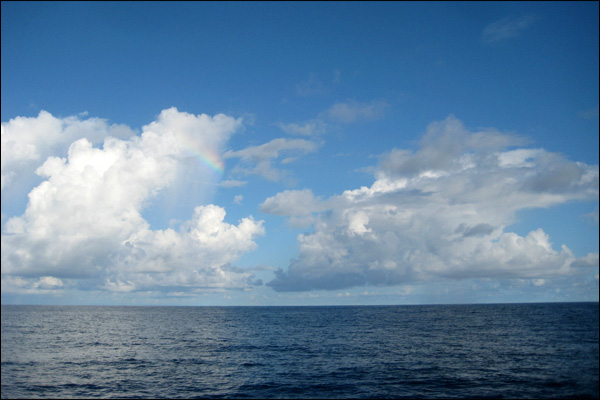 |
| Heading south from the Galapagos. Next stop Easter Island. |
We were half way to Easter Island from the Galapagos and from there we were headed to the fjords of Chile.
But it was not to be. We knew we would only get more tired and the safety of our family in a vast empty sea would be at risk. I had resisted abandoning the plan. I wanted the children to see that dreams and plans can be fulfilled.
And suddenly, with a turn of the wheel, we had no plan.
We had not even planned out alternative ports of call on the South American coast. Smashing up and down 15 foot waves in a state of sleep deprivation did not allow for thoughtful planning, other than knowing that we might not want to be south of the hurricane belt at the change of seasons.
On our southern path, I had not been prepared for the rush of emotion that filled me on first sighting again the star formation that had hung in my childhood skies. Sailing under the Southern Cross as we pursued our beautiful adventure with our children overwhelmed me with happiness. Turning my back on it again and on all I had envisaged broke my heart.
The cruising books and magazines seem to be filled only with the success stories that we want to emulate or else catastrophic survival stories that we hope to avoid, but they gloss over, or we choose to ignore, the single sentence that says they were hauled out for a year, or left their boat for years while they returned home to earn more money. And this distorts the reality for us. All the success stories we hear mask the lonely private losses and frustrations that so many more of us experience.
We opted to return to our last port of call in the Galapagos and from there we headed straight for Mexico and safety from hurricanes.
My tears were soon tempered by the discovery that we were not alone in our disappointment.
We met a girl in the Galapagos, left behind by the crew who had had to return to Panama when their 21 day permit expired and they required too many repairs to achieve the Pacific crossing that season. She was hospitalized with kidney stones and waved good-bye to her boyfriend, who got a crewing position on a west-bound boat.
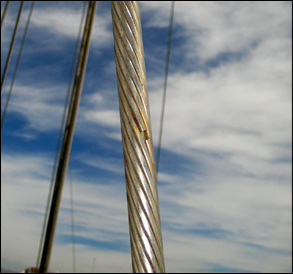 |
| We thought we were ready to go…and found the cracked stay. |
On arriving back in La Cruz, in Mexico, we met crews who had made two attempts at that season’s Puddle Jump but had turned back both times with engine troubles while the fleet sailed on without them.
Friends who were on their way round the “Big U” were forced to return to Mexico for repairs when another boat in their anchorage dragged and pounded theirs in a storm.
Our own initial departure had been delayed by a year, first by rigging repairs and then by my husband’s potentially catastrophic back injury on the eve of departure.
Through this experience and hearing of others, I learned that it is so important to make something positive out of the negative.
The happiest man we ever met was one whose plans to sail with his family had first been thwarted by divorce and then by life-threatening illness when his daughters were grown and he was on the point of sailing off.
We rushed on deck to the sound of crunching metal as a power boat swiped across this man’s bow, but his only response was a cheery request to talk about it when they got back. To which my eldest spluttered that he was jumping ship to crew for him.
The secret to his happiness, he told me, was that he was finally fulfilling his dreams after so many set-backs and he was not about to make his life miserable by getting angry about anything. He was happy because he was finally living his dream, but we have to see the gains that can be made out of the frustrating times when our dreams seem anything but fulfilled.
We feel we have failed, and yet true failure is never having tried; never having the guts to face the possibility of failure. So when the tide comes in and washes away those plans we wrote in the sand, what do we do?
We live life to the full in the very place we find ourselves. We gained so much from our change of plans.
Not least was the kind support and comfort of the friends who had successfully made the whole journey to Chile and emailed to see where we were.
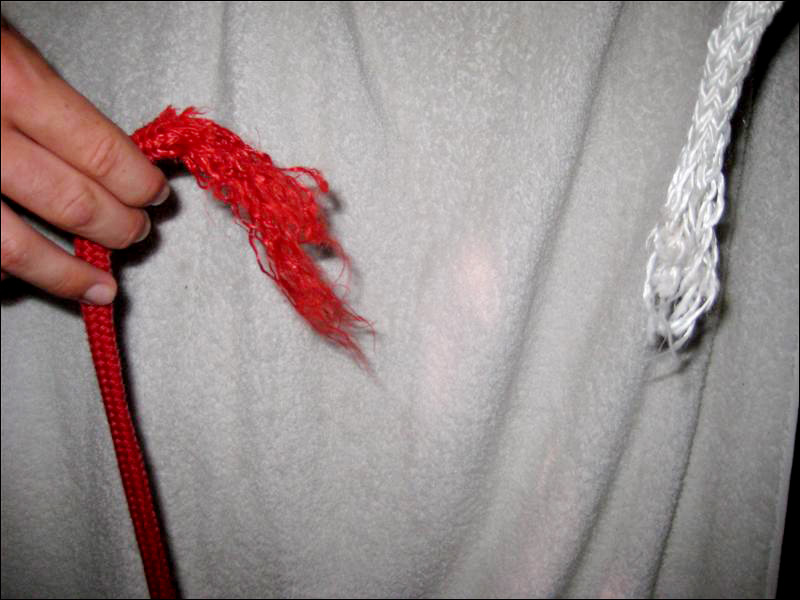 |
| The blown jib furling line. We repaired/replaced and blew this line three times on the way back to Galapagos. |
It was also reinforcement of our decision to turn around, as they told us of 60 knot winds, high seas and 9o C temperatures. As it happened, on our northward return we blew a jib line and broke the steering chain. Both were so much easier to repair in the calmer seas we had towards the ITCZ than they would have been heading south.
On our southward journey we had been so driven by the need to make progress that we hadn’t taken time to explore along the way. Our northward trip was filled with so many more adventures and we even took time to travel inland.
Returning to our starting point of Ensenada, however, felt like the definition of failure. But even there, the 6 months we spent were filled with the richest opportunities our kids had had.
- Our eldest enrolled at the local university for an advanced Spanish course and joined the faculty as a volunteer English Lab tutor before heading to university in Australia.
- Our second son, who plans to pursue musical performance, joined the local youth orchestra as first flute, and initiated a wind ensemble.
- Our daughter continued her earlier studies of Mexican Folklorico dancing and performed with her group on numerous occasions.
- Our youngest son was finally able to learn to ride a bicycle, which he used to ride to piano lessons with a fabulous teacher, whose studio was near the marina.
 |
| Isabelle (center) performing with a folklorico group in Ensenada. |
What had seemed a shameful failure turned out to be the opportunity of a life time. Similarly, the friends who had to turn back for repairs, are now settled in Mexico with both children becoming fluent in Spanish.
We need to make plans. In our case, we should have made many more plans that included more places to make landfall, or even to head due west. Having alternative plans is the best way to make sure you come out well from set-backs.
However, making physical progress along a chart is not the only way to have an adventure. Even being delayed in some port of your home country is an opportunity to explore and enrich your life. Look at your port town like a cruiser. Find the fun markets, the free family entertainment and festivals, the thrift and second hand book stores. Join a group at the library or start one in your marina. Devote time to learning the languages you will need or going to classes for skills to make you more confident at sea.
As Marcel Proust put it,
The real voyage of discovery consists not in seeking new landscapes,
but in having new eyes.
Recently my husband bought me an international cell phone, and its default screen saver was the heads of Easter Island. I had to ask him to change it for me; New eyes or not, I was not quite ready to look at that particular lost dream.
About Clare Collins
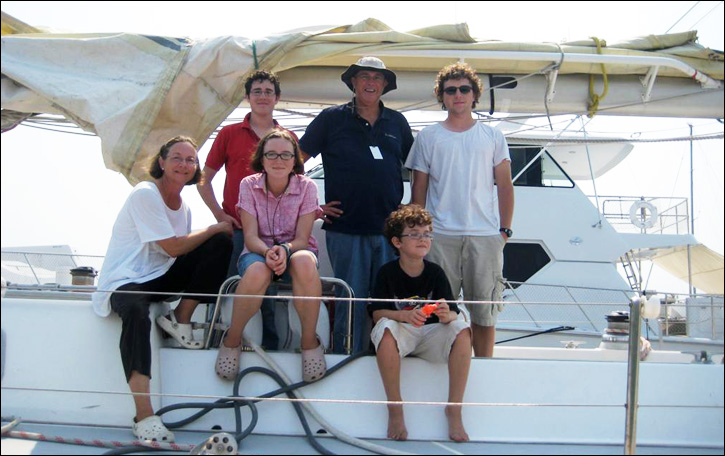
Clare and her family have lived aboard and cruised in their 72 foot steel Challenge racing boat since 2008. They are currently stationary while the kitty gets replenished and children take part in musical and academic pursuits.
Clare believes that with the attitude of adventure you can be a cruiser anywhere you find yourself.
More from Clare Collins, on this website
- Fighting Fears: Taking the Plunge (Feature article)
The account of Clare family’s quest to fulfill their dream of sailing - Staying pink in a blue world (Blog)
- First cruising adventure: Our best and worst moments (Blog)

